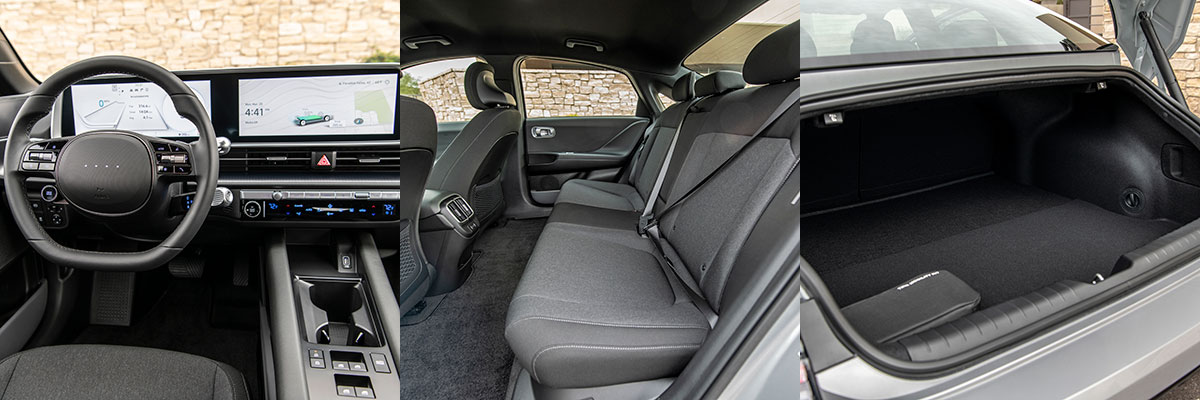Hot on the heels of its Ioniq 5 EV wagon, Hyundai introduces its first EV sedan, aptly named Ioniq 6. Though it's slightly smaller than the Ioniq 5 it shares architecture, batteries and electric motors. The only direct competitor in the sedan classification is the Tesla Model 3, though the more expensive BMW i4 and Polestar 2 are also EV sedans.
The Ioniq 6 model lineup indludes the SE Standard Range, SE, SEL and Limited. SE Standard Range comes with a 53-kWh battery and single 149-horsepower electric motor driving the rear wheels and providing an EPA estimated range of 240 miles. SE, SEL and Limited get a larger 77-kWh battery. SE gets a more-powerful 225-horsepower engine driving the rear wheel and an EPA estimated range of 361 miles. All-wheel drive is optional and adds a second motor to the front wheels increasing total power to 320 horsepower, but range drops to 316. SEL and Limited get the same rear- or all-wheel drive setups but range drops to 305 and 270, respectively.
Prices start at $42,000 for the SE Standard Range and go up to more than $53,000 on the Limited. Standard safety features include forward-collision warning with automatic braking, adaptive cruise control, blind-spot warning with rear cross-traffic alert, lane-keeping assistance with lane centering, intersection collision mitigation, front and rear parking sensors and drive attention monitor. Also standard are LED lighting, DC fast-charging capability, heat pump, keyless entry and start, dual zone climate control, heated front seats and 12.3-inch infotainment touchscreen with support for Android Auto and Apple Car Play.

Though the Ioniq 6 trails the Tesla Model 3 in overall acceleration, it's still quick. The dual-motor all-wheel-drive model will sprint from 0-60 MPH is about 4.5 seconds. Single-motor models are significantly slower, but still fairly quick 0-30 MPH. Like most electric vehicles, the Ioniq 6 runs out of steam on the highway and provides only modest passing punch. No matter what, acceleration is smooth and linear.
Ioniq 6 offers several different drive modes as well as independent settings for the about of electricity regeneration provided when coasting. There is a true 1-pedal driving mode, but it's not the most efficient mode overall. For best range, it's best to drive in 2-pedal mode with the brake regenerator set to Auto.
One of the quickest charging EVs on the market, the Ioniq 6 can charge at a rate of 350 kW in perfect conditions at a DC fast charger. However, in real-world situations most owners will likely charge at a 150 kW rate. Still that's good enough to get from 10 to 80 percent battery in about 30 minutes.
Though the Ioniq 6 comes in at a portly 4,600 pounds in dual motor trim, it's feels nimble and athletic around town. Part of that has to do with quick and accurate steering and a LOT of weight below the center of gravity (thanks to the low-placed battery). The tires have amply dry-road grip and the suspension, while not overly firm, provides enough rebound resistance to keep Ioniq 6 under control. About the only flaw is in quick changes of direction where the battery's weight create an uneasy queasiness.
As mentioned, the suspension is perfectly suited to providing a smooth, controlled and comfortable ride. There's good impact absorption, even when fitted with the 20-inch tires. Interior noise levels are extremely low and the Ioniq 6 proves to be a near-perfect highway cruiser.
With several different driving modes and the ability to adjust brake regeneration, most drivers will quickly find a setting that suites their driving style. It should be noted that driving in 1-pedal mode is not really recommended for best efficiency on the highway as it keeps the front motor engaged at all times.

Inside, Hyundai has gone all Ludwig Mies van der Rohe taking the theme "less is more" to the extreme. The doors for example have no switchgear, just a pull to open. Window and mirror controls are on the console between the front seats. There are no radio controls at all in the center stack. Climate controls are few and far between. Most functions are controlled by steering-wheel-mounted buttons or the infotainment touchscreen. Materials are sturdy, but clearly designed to meet a price point. Forward visibility is great, but the view out the back is pinched by the sloping roofline and thick rear pillars. Overall, its modern, but far from first class.
The front seats are firmly bolstered but offer good support and plenty of adjustment. Both head and leg room are good up front. Rear seats are firm as well and the seatback is upright. Leg room exceptional and the floor is flat. Head room is tight thanks to the low roofline, which also complicated entry and exit.
From a technology standpoint, Ioniq 6 packs just about all the safety and technology features anyone could want. The only curious omission is wireless support for Android Auto and Apple Car Play. The infotainment system boasts a large touchscreen, but it's a long stretch for drivers and also somewhat slow to respond to input. One nice feature is route planning that takes into account EV range and charging stations along the way.
Say what you will about the slippery aerodynamic shape of the Ioniq 6, but there's no denying it impacts cargo capacity. With just 11.2 cubic feet of covered storage, it's got less room than most subcompact cars. That's a huge handicap for a vehicle that's designed for family use. Interior storage is just OK with a typical glovebox, map pockets and center console bin.
Bottom Line - Ioniq 6 is the first widely available midsize sedan EV from mainstream automakers. It's mostly a hit, but there are some misses like rear-seat headroom, cargo capacity and middling interior materials. It's also priced about $10,000 more than a typical midsize sedan, and that might be it's biggest weakness. Impressive range of the SE model notwithstanding, the best bet might be SEL AWD.
|
|